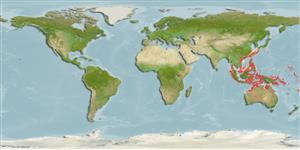Environment: milieu / climate zone / depth range / distribution range
Ecologia
marinhas associadas(os) a recifes; intervalo de profundidade 40 - 130 m (Ref. 5222). Tropical; 34°N - 20°S, 92°E - 177°W
Western Pacific: Andaman Sea to southern Japan, Taiwan, China, Philippines, Viet Nam, Malaysia, Thailand, Indonesia, New Guinea, the Arafura Sea (Ref. 9819), northwestern Australia, and Fiji.
Tamanho / Peso / Idade
Maturity: Lm ? range ? - ? cm
Max length : 50.0 cm TL macho/indeterminado; (Ref. 5222)
Espinhos dorsais (total): 11; Raios dorsais (total): 15-16; Espinhos anais 3; Raios anais : 8. This species is distinguished by the following characters: body depth less than head length, 2.5-3.0 times in SL; large head length 2.1-2.4 times in SL; rounded preopercle with 3-6 enlarged serrae at the angle; upper edge of operculum slightly convex; midside of lower jaw with 2 rows of teeth; gill rakers of first gill arch 8 + 14-16 = 22-24; scaly maxilla, reaching about vertical at rear edge of eye; pectoral and pelvic fin length are equal, 1.7-2.3 times in head length; ctenoid lateral body scales, few auxiliary scales in adults. Colour of head, body and median fins are pale grey; 5 broad dark brown bars, first 2 extending into the spinous part of dorsal fin, 3rd and 4th bars extending into the soft dorsal and anal fins, 5th dark bar at the base of the caudal fin; edges of dorsal parts of body bars with small black spots; nape with dark brown saddle blotch, small black spots mainly along edge of the blotch; cheeks, snout, interorbital area, jaws and chest mostly dark brown, with 2-3 white bands radiating from the eye; irregular black bar on the middle of the caudal fin; yellow maxillary groove; small juveniles (6 cm SL) white, with black bars on body as described for adults, the fins pale yellow with small black spots (Ref. 39231, 89707).
This species is usually found on offshore coral and rocky reefs. A popular and commercially important species in Hong Kong, but not in Singapore. Caught with hand lines and sold fresh (Ref. 39231).
Ciclo de vida ou comportamento de acasalamento
Maturidade | Reprodução | Desova | Ovos | Fecundidade | Larvas
Heemstra, P.C. and J.E. Randall, 1993. FAO Species Catalogue. Vol. 16. Groupers of the world (family Serranidae, subfamily Epinephelinae). An annotated and illustrated catalogue of the grouper, rockcod, hind, coral grouper and lyretail species known to date. Rome: FAO. FAO Fish. Synop. 125(16):382 p. (Ref. 5222)
Status na Lista Vermelha da UICN (Ref. 130435)
Ameaça para os humanos
Harmless
Uso pelos humanos
Pescarias: pouco comercial
Mais informação
Nomes comunsSinônimosMetabolismoPredadoresEcotoxicologiaReproduçãoMaturidadeDesovaAgregação de desovaFecundidadeOvosDesenvolvimento dos ovos
ReferênciasAquaculturaPerfil para aquaculturaEstirpesGenéticaElectrophoresesHereditariedadeDoençasProcessamentoNutrientsConversão de massa
ColaboradoresFotosStamps, Coins Misc.SonsCiguateraVelocidadeTipo de nataçãoÁrea branquialOtólitosCérebrosVisão
Ferramentas
Relatórios especiais
Baixar XML
Fontes da internet
Estimates based on models
Preferred temperature (Ref.
123201): 20.2 - 27.6, mean 23.9 °C (based on 136 cells).
Índice de diversidade filogenética (Ref.
82804): PD
50 = 0.5000 [Uniqueness, from 0.5 = low to 2.0 = high].
Bayesian length-weight: a=0.01175 (0.00571 - 0.02419), b=3.04 (2.88 - 3.20), in cm total length, based on LWR estimates for this Genus-body shape (Ref.
93245).
Nível Trófico (Ref.
69278): 3.8 ±0.5 se; based on size and trophs of closest relatives
Resiliência (Ref.
120179): médio(a), tempo mínimo de duplicação da população 1,4 - 4,4 anos (Preliminary K or Fecundity.).
Fishing Vulnerability (Ref.
59153): Moderate vulnerability (40 of 100).
Nutrients (Ref.
124155): Calcium = 27.2 [13.3, 56.6] mg/100g; Iron = 0.481 [0.260, 0.967] mg/100g; Protein = 18.5 [16.9, 19.8] %; Omega3 = 0.134 [0.086, 0.211] g/100g; Selenium = 40 [24, 68] μg/100g; VitaminA = 186 [54, 642] μg/100g; Zinc = 1.26 [0.89, 1.76] mg/100g (wet weight);
